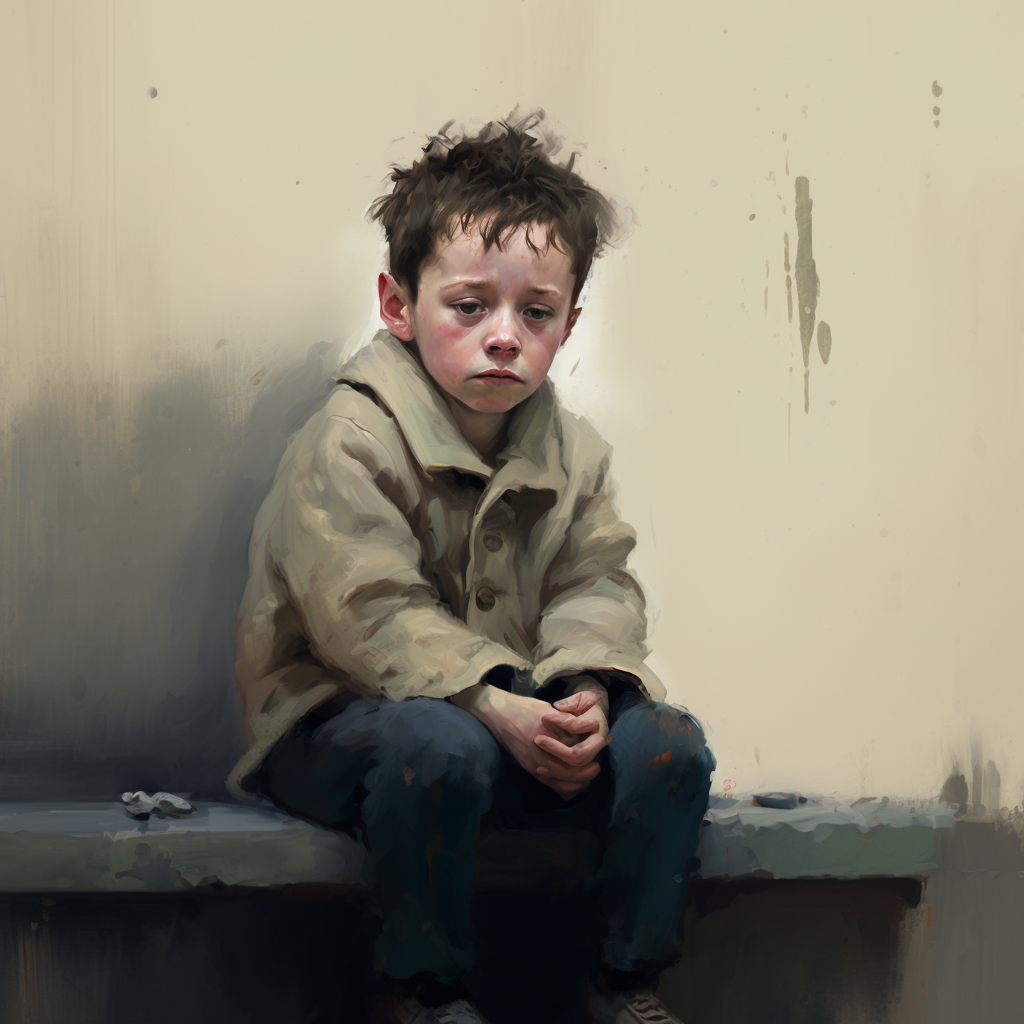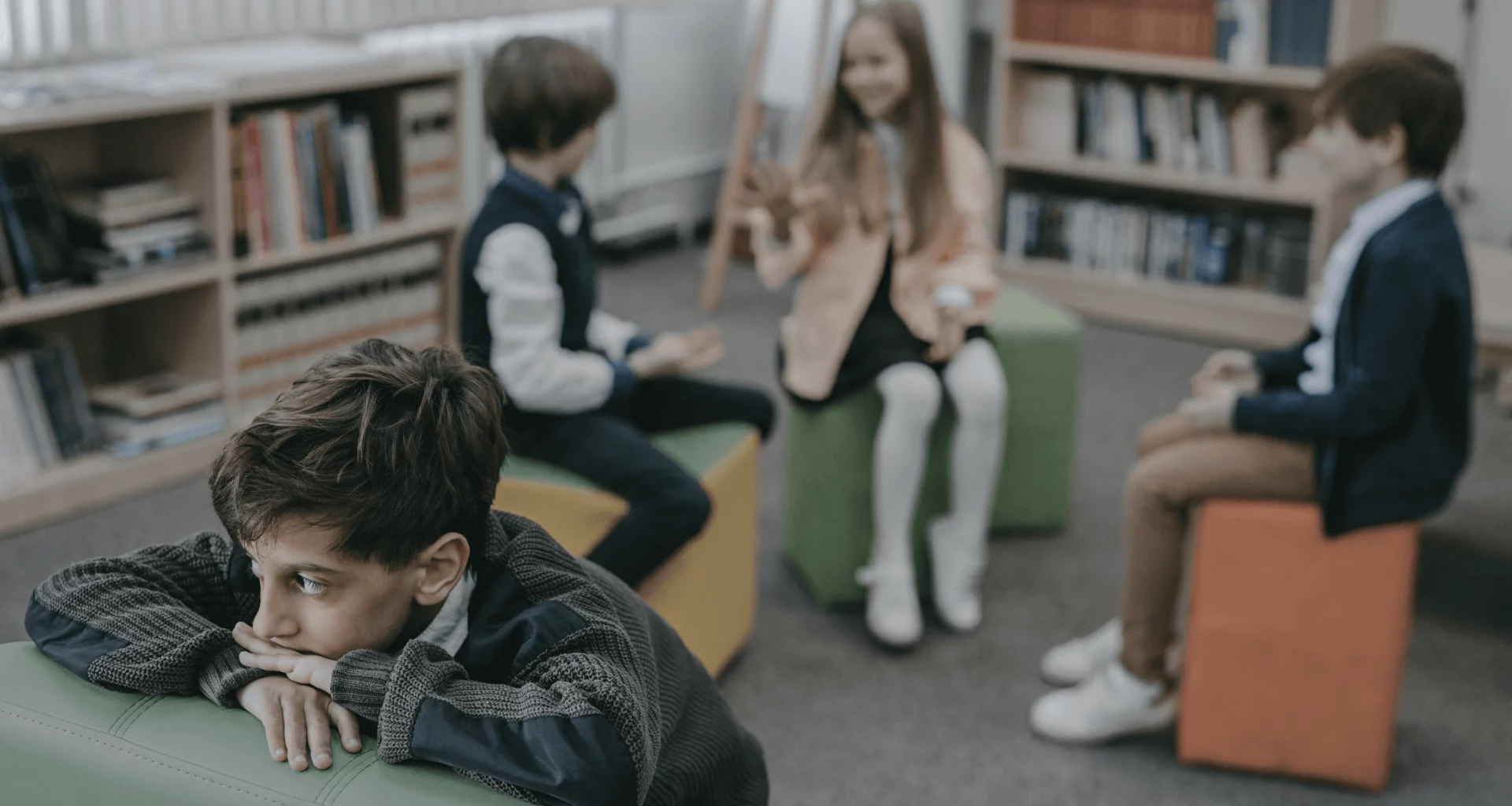Childhood anxiety is a common mental health issue that affects many children across the world. Anxiety can be caused by a range of factors, including genetics, environment, and life events. While it is normal for children to experience anxiety from time to time, persistent and severe anxiety can have a significant impact on a child’s mental health and overall well-being.
Table of Contents
- Types of Childhood Anxiety
- Causes of Childhood Anxiety
- Signs and Symptoms of Childhood Anxiety
- The Role of Parents in Managing Childhood Anxiety
- How Anxiety Can Affect Children’s Academic Performance
- The Relationship Between Childhood Anxiety and Social skills
- The Connection Between Anxiety and Physical Health
- How Schools Can Support Anxious Students
- Treatment Options for Childhood Anxiety
- The Importance of Early Intervention for Childhood Anxiety
- Coping Skills for Anxious Children
- Frequently Asked Questions

Types of Childhood Anxiety
Generalized Anxiety Disorder (GAD)
GAD is a type of anxiety that involves excessive and persistent worry about everyday life events or activities, such as school, relationships, health, and safety. Children with GAD tend to be perfectionists, self-critical and have difficulty making decisions or taking risks. They may also experience physical symptoms like muscle tension, headaches, and stomach aches.
Separation Anxiety Disorder (SAD)
SAD is a type of anxiety that occurs when a child experiences excessive fear or anxiety about separation from a primary caregiver, such as a parent or guardian. Children with SAD may experience nightmares, refusal to go to school or other places without their caregiver, physical symptoms like nausea or vomiting, and persistent worries about the safety of their caregiver.
Social Anxiety Disorder (SAD)
SAD is a type of anxiety that involves excessive fear or anxiety of social situations or performance situations, where the child fears being judged, criticized, or embarrassed. Children with SAD may avoid social situations, have difficulty making friends, and experience physical symptoms such as sweating, blushing, or trembling.
Specific Phobias
Specific phobias are intense fears or anxiety triggered by specific objects or situations, such as animals, heights, or medical procedures. Children with specific phobias may avoid the object or situation or endure it with intense fear or anxiety.
Panic Disorder
Panic disorder is a type of anxiety that involves recurrent panic attacks, which are sudden episodes of intense fear or discomfort accompanied by physical symptoms like chest pain, shortness of breath, and sweating. Children with panic disorder may avoid situations or activities that trigger panic attacks, which can interfere with daily life functioning.
Obsessive-Compulsive Disorder (OCD)
OCD is a type of anxiety that involves recurrent and intrusive thoughts or images (obsessions) that are accompanied by repetitive behaviors or mental acts (compulsions) aimed at reducing anxiety. Children with OCD may engage in excessive hand washing, checking, or counting, which can interfere with daily life functioning.
Childhood anxiety can manifest in different forms, each with its unique characteristics, symptoms, and triggers. Understanding the different types of anxiety can help parents, teachers, and mental health professionals to identify and support children experiencing anxiety.
Causes of Childhood Anxiety
Genetics
Research suggests that there may be a genetic component to anxiety disorders and that children with a family history of anxiety disorders may be more likely to develop an anxiety disorder themselves. A study found that children with a family history of anxiety disorders were more likely to develop an anxiety disorder themselves and that the risk was even higher if the parent had a comorbid mood disorder.
Brain chemistry
Anxiety disorders are associated with differences in brain chemistry and activity, particularly in the amygdala, which is the part of the brain that processes emotions. Research suggests that children with anxiety disorders may have an overactive amygdala, which can make them more reactive to stress and anxiety. One study found that children with anxiety disorders had increased amygdala activity in response to fearful stimuli.
Trauma or stress
Experiences of trauma or chronic stress, such as abuse, neglect, or parental divorce, can increase a child’s risk of developing an anxiety disorder. A study found that children who experienced early life stress, such as parental divorce or abuse, were more likely to develop anxiety disorders.
Parenting style
Parenting style can also play a role in the development of childhood anxiety. Overprotective parenting or parenting that is high in criticism or negativity can increase a child’s risk of developing an anxiety disorder. A study found that children with anxiety disorders were more likely to have parents who were overprotective, critical, or negative.
Social and environmental factors
Social and environmental factors, such as poverty, neighborhood violence, or discrimination, can also increase a child’s risk of developing an anxiety disorder. A study found that children living in poverty were at higher risk for anxiety disorders and that this risk was partially mediated by exposure to violence and other stressors.
Signs and Symptoms of Childhood Anxiety
Physical symptoms
Children with anxiety may experience a range of physical symptoms, including but not limited to stomachaches, headaches, nausea, vomiting, diarrhea, and fatigue. These physical symptoms may result from the fight or flight response triggered by anxiety, causing an increase in heart rate, rapid breathing, and muscle tension.
Behavioral symptoms:
Anxiety can also affect a child’s behavior, leading to avoidance or escape behaviors, such as refusing to go to school or social events, or excessive clinging to parents or caregivers. Children with anxiety may also exhibit compulsive behaviors, such as repetitive hand washing, checking locks, or lining up objects.
Emotional symptoms
Anxiety can also affect a child’s emotions, leading to feelings of worry, fear, sadness, irritability, or anger. Children with anxiety may also have low self-esteem, poor self-confidence, and negative self-talk.
Cognitive symptoms
Anxiety can also affect a child’s thinking, leading to persistent and excessive worry about future events or past experiences. Children with anxiety may have difficulty concentrating, be easily distracted, and have trouble sleeping due to racing thoughts. They may also have irrational fears or beliefs, such as believing that something bad will happen if they don’t perform a ritual.
Social symptoms
Anxiety can also affect a child’s social functioning, leading to difficulty making friends, maintaining relationships, and participating in social activities. Children with anxiety may also have trouble communicating their feelings or needs, and they may have trouble expressing themselves appropriately in social situations.
The Role of Parents in Managing Childhood Anxiety
Provide a safe and secure environment
Children need to feel safe and secure in their environment to help reduce their anxiety. Parents can create a supportive and nurturing environment by providing a routine, structure, and consistency in their child’s daily life. Children thrive on routine and knowing what to expect.
According to a study, “anxiety disorders in children are influenced by a combination of individual, environmental, and familial factors.” The study also suggests that family factors such as parenting style, family conflict, and parental anxiety can have a significant impact on a child’s anxiety levels.
Encourage open communication
It is essential to encourage open communication between the child and the parent to understand what triggers the child’s anxiety. Parents can help their children identify and express their feelings to help them develop effective coping skills. Parents should create a safe space where the child can openly express their feelings without fear of judgment.
According to an article, “Open communication between parents and children is critical in the prevention and management of anxiety disorders in children.” The study suggests that open communication can help children develop coping strategies and increase resilience.
Model healthy coping strategies
Children learn by example, and parents can model healthy coping strategies to help their children manage their anxiety. Parents can demonstrate relaxation techniques, such as deep breathing, mindfulness, and meditation. Parents should also encourage physical activity and healthy habits, such as getting enough sleep and eating a healthy diet.
According to a study, “parental modeling of healthy coping strategies is associated with reduced anxiety symptoms in children.” The study suggests that parental modeling can positively impact a child’s anxiety levels.
Seek professional help
If a child’s anxiety is interfering with their daily life, parents should seek professional help. A mental health professional can work with the child and the family to develop a treatment plan that works best for the child’s needs. Treatment options may include therapy, medication, or a combination of both.
According to an article, “Early intervention is crucial in the management of childhood anxiety disorders.” The article suggests that seeking professional help can lead to better outcomes for the child in the long run.
How Anxiety Can Affect Children’s Academic Performance
Difficulty with Attention and Concentration
Children with anxiety may find it challenging to focus and concentrate in school. According to a study, anxiety disorders were significantly associated with attention problems among school-aged children. Children with anxiety may have racing thoughts and worry about future events, making it difficult to concentrate on the present moment.
Poor Test Performance
Test-taking can be a significant source of anxiety for many students, leading to poor performance. A study found that children with anxiety disorders scored significantly lower on standardized achievement tests than children without anxiety disorders. Anxiety can interfere with a child’s ability to recall information accurately, leading to lower scores on tests.
School Absenteeism
Children with anxiety may miss school due to their symptoms, leading to increased absenteeism. According to a study, anxiety was significantly associated with school absenteeism among children. Missing school can result in missed instructional time and a lack of understanding of critical concepts, leading to further academic struggles.
Difficulty Participating in Class
Anxiety can cause children to feel self-conscious and embarrassed, leading to avoidance of participation in class. A study found that social anxiety disorder was significantly associated with lower levels of classroom participation among adolescents. Children with anxiety may be afraid of being judged or evaluated by their peers, leading to avoidance of participation in class activities.
Poor Time Management
Anxiety can make it challenging for children to manage their time effectively, leading to procrastination and incomplete assignments. According to a study, students with high levels of test anxiety were more likely to procrastinate when completing assignments. Poor time management can result in missed deadlines and incomplete assignments, leading to lower grades and increased stress.
Anxiety can have a significant impact on children’s academic performance, leading to difficulties with attention and concentration, poor test performance, school absenteeism, difficulty participating in class, and poor time management. Parents, teachers, and mental health professionals should be aware of these potential consequences and work together to provide support and resources for children with anxiety to help them succeed academically.
The Relationship Between Childhood Anxiety and Social skills
Anxiety can lead to poor social skills
Children with anxiety may struggle with social interactions, including initiating and maintaining conversations, interpreting social cues, and expressing emotions appropriately. Research has found that children with anxiety disorders, such as social anxiety disorder, are more likely to have poor social skills compared to their peers without anxiety.
Social skills training can help alleviate anxiety
Social skills training is an evidence-based intervention that focuses on teaching children the necessary skills to initiate and maintain social interactions. Studies have found that social skills training can improve both social skills and anxiety symptoms in children with anxiety disorders.
Parental involvement is essential
Parents play a critical role in supporting their children’s social development. Parents can model appropriate social behaviors, provide opportunities for socialization, and encourage positive peer relationships. Studies have found that parental involvement in social skills training can enhance the effectiveness of the intervention.
Peer relationships can be impacted by anxiety
Children with anxiety may struggle to establish and maintain positive peer relationships, which can lead to social isolation and further exacerbate anxiety symptoms. Studies have found that children with anxiety disorders are more likely to have peer relationship problems, including being rejected by peers.
Social support can help alleviate anxiety
Social support from peers can be a protective factor for children with anxiety. Positive peer relationships can provide a sense of belonging and emotional support, which can help alleviate anxiety symptoms. Studies have found that having supportive friendships can reduce anxiety symptoms in children with anxiety disorders.
Childhood anxiety can impact a child’s social skills, leading to difficulties in social interactions and peer relationships. However, social skills training, parental involvement, and positive peer relationships can all help alleviate anxiety symptoms and improve social skills in children with anxiety disorders.
The Connection Between Anxiety and Physical Health
Cardiovascular System
Anxiety can lead to increased heart rate, elevated blood pressure, and constriction of blood vessels, which can put a strain on the cardiovascular system. According to a study, anxiety is associated with an increased risk of developing coronary heart disease (CHD), a condition that occurs when plaque builds up in the arteries that supply blood to the heart.
Respiratory System
Anxiety can also affect the respiratory system, causing shortness of breath, rapid breathing, and chest tightness. In severe cases, anxiety can lead to panic attacks, which can cause hyperventilation and further exacerbate respiratory symptoms. According to a study people with anxiety disorders are more likely to develop respiratory diseases such as asthma and chronic obstructive pulmonary disease (COPD).
Digestive System
Anxiety can also impact the digestive system, causing symptoms such as stomach pain, diarrhea, and constipation. According to a study, people with anxiety disorders are more likely to develop gastrointestinal disorders such as irritable bowel syndrome (IBS).
Immune System
Anxiety can also weaken the immune system, making individuals more susceptible to infections and illnesses. According to a study published in the Journal of Psychiatric Research, people with anxiety disorders have an increased risk of developing autoimmune diseases such as rheumatoid arthritis and lupus.
Musculoskeletal System
Anxiety can cause tension in muscles and lead to pain in the neck, shoulders, and back. According to a study people with anxiety disorders are more likely to develop chronic pain conditions such as fibromyalgia.
Anxiety can have a significant impact on physical health, affecting multiple systems in the body. Therefore, it is crucial to seek help and treatment for anxiety to improve both mental and physical health.
How Schools Can Support Anxious Students
Promote an open and accepting environment
Schools can create a safe environment for anxious students by promoting a culture of acceptance, kindness, and understanding. This is achieved by training teachers and staff to identify and support anxious students and providing resources such as mental health professionals to students who may require more support.
Encourage stress-management strategies
Create individualized plans
Schools can develop individualized plans for anxious students, which can include strategies such as breaks or shortened assignments. By working with students, parents, and mental health professionals, schools can provide students with the support they need to thrive academically and emotionally. Exercise has been found to have positive effects on mental health and can reduce anxiety symptoms in children. Schools can incorporate physical activity into their curriculum or provide opportunities for students to participate in sports or other activities. Schools can educate both students and staff about anxiety disorders to reduce stigma and promote understanding. This can include presentations, workshops, or training sessions on the signs and symptoms of anxiety disorders and how to support those who may be struggling. Schools can provide access to mental health professionals, such as school psychologists, social workers, or counselors, to support anxious students. These professionals can provide individual or group therapy, support in developing coping strategies, and offer referrals for outside resources if necessary. Strong relationships with teachers, peers, and other adults in the school can provide a sense of belonging and support for anxious students. Schools can encourage and promote these relationships by providing opportunities for students to interact with teachers outside of the classroom or by creating peer mentorship programs. CBT is a type of psychotherapy that helps children learn how to identify and manage their anxious thoughts and behaviors. This therapy has been found to be effective in treating various anxiety disorders in children, including separation anxiety disorder, social anxiety disorder, and generalized anxiety disorder (GAD). According to a study, CBT was found to be more effective than a wait-list control in reducing anxiety symptoms in children with GAD. Antidepressants and anti-anxiety medications is used to treat childhood anxiety. Selective serotonin reuptake inhibitors (SSRIs) are the most commonly prescribed medications for anxiety disorders in children. However, medication should only be used in severe cases of childhood anxiety and under the guidance of a qualified healthcare provider. A study found that a combination of medication and CBT was more effective than either treatment alone in treating pediatric anxiety disorders. Mindfulness-based interventions (MBIs) such as mindfulness meditation and yoga was found to be effective in reducing anxiety symptoms in children. MBIs help children develop skills to manage their emotions and thoughts effectively. A study found that mindfulness-based stress reduction (MBSR) was effective in reducing anxiety symptoms in children with anxiety disorders. Parenting interventions that teach parents how to support their anxious children have been found to be effective in reducing anxiety symptoms in children. These interventions include parent-child interaction therapy (PCIT), parent management training (PMT), and the Coping Cat program. A study found that a group-based parenting intervention called the Cool Kids program was effective in reducing anxiety symptoms in children. Play therapy is a form of therapy that uses play as a means of communication between the child and therapist. It is particularly useful in treating young children with anxiety disorders. According to a study, play therapy was found to be effective in reducing anxiety symptoms in children with anxiety disorders. Childhood anxiety is a treatable mental health issue. Cognitive-behavioral therapy, medication, mindfulness-based interventions, parenting interventions, and play therapy are effective treatment options for childhood anxiety. It is essential to seek professional help from a qualified healthcare provider to determine the best treatment approach for each child. Overprotective parenting or parenting that is high in criticism or negativity can increase a child’s risk of developing an anxiety disorder. Research has shown that childhood anxiety is a risk factor for the development of anxiety and mood disorders in adolescence and adulthood. However, early intervention can prevent the progression of anxiety disorders and decrease the likelihood of a child developing chronic anxiety later in life. A study found that children who received early intervention for anxiety had significantly lower rates of anxiety disorders at a six-year follow-up than children who did not receive early intervention. Anxiety can have a significant impact on a child’s academic performance. Children with anxiety may have difficulty concentrating in class, completing assignments, and participating in school activities. Early intervention can help children develop coping strategies and increase their confidence, leading to better academic performance. A study found that school-based interventions for anxiety were effective in improving academic performance. Children with anxiety often struggle with social interactions, making it difficult for them to form and maintain friendships. Early intervention can help children develop social skills and improve their ability to interact with peers. A study found that group cognitive-behavioral therapy (CBT) interventions for anxious children led to significant improvements in social skills. Anxiety can have a significant impact on a child’s physical health. Children with anxiety may experience headaches, stomach aches, and other physical symptoms. Early intervention can help reduce these symptoms and improve a child’s overall physical health. A study found that a mindfulness-based intervention for children with anxiety led to improvements in physical health and quality of life. When left untreated, childhood anxiety can become more severe and require more intensive treatments, such as medication or intensive therapy. Early intervention can reduce the need for these treatments by addressing anxiety symptoms before they become more severe. A study found that early intervention for anxiety led to significant reductions in the need for more intensive treatments. Childhood anxiety is a serious condition that requires early intervention to prevent long-term negative effects. Seeking help as early as possible can prevent the development of chronic anxiety disorders, improve academic performance and social skills, improve physical health, and reduce the need for more intensive treatments. Parents, teachers, and healthcare providers must work together to identify and treat anxiety in children to ensure they have the best possible outcome for their future. Deep breathing exercises are a simple yet effective way for children to calm down when feeling anxious. It involves taking slow, deep breaths through the nose and exhaling slowly through the mouth. Studies have shown that deep breathing exercises can help reduce anxiety and improve mood. Progressive muscle relaxation is a technique that involves tensing and relaxing different muscle groups to reduce physical tension and anxiety. Teach children to systematically tense and relax their muscles, starting from their toes all the way up to their heads. Research has shown that progressive muscle relaxation can reduce anxiety in children. Mindfulness meditation involves paying attention to the present moment without judgment. It can help children become more aware of their thoughts and feelings and reduce anxiety. Research has shown that mindfulness meditation can improve emotion regulation and reduce anxiety in children and adolescents. Physical exercise is a great way for children to release pent-up energy and reduce stress. It can also help improve mood and self-esteem. Studies have shown that regular physical exercise can reduce symptoms of anxiety in children and adolescents. Encouraging children to replace negative thoughts with positive self-talk can help reduce anxiety and improve self-esteem. This involves identifying negative thoughts and replacing them with positive affirmations. Research has shown that positive self-talk can improve emotional regulation and reduce anxiety in children. Having a support system, whether it’s family, friends, or a therapist, can be beneficial for anxious children. Social support can provide a sense of safety and security, reduce feelings of isolation, and improve overall well-being. Studies have shown that social support can reduce symptoms of anxiety in children and adolescents. Encouraging children to express themselves creatively through art, music, or writing can be a helpful coping mechanism for anxiety. Creative expression allows children to channel their emotions in a positive way and can improve mood and self-esteem. Research has shown that creative arts interventions can reduce symptoms of anxiety in children and adolescents. Anxiety can be challenging for children to manage, but equipping them with coping skills can make a significant difference in their overall well-being. The coping skills mentioned above are backed by research and can help children learn to manage their anxiety and improve their quality of life. Distinguishing between normal childhood worries and anxiety depends on the intensity, duration, and impact on daily functioning. Normal worries are temporary and do not significantly interfere with a child’s ability to participate in activities or enjoy life. Anxiety, on the other hand, is persistent, excessive, and may lead to avoidance or impairment in various areas of a child’s life. Strategies to help your child cope with anxiety include teaching relaxation techniques like deep breathing or mindfulness, providing a safe and supportive environment for open communication, encouraging healthy coping mechanisms such as exercise or hobbies, promoting positive self-talk and problem-solving skills, and seeking professional guidance if needed. In some cases, childhood anxiety may lessen or go away on its own as a child matures and learns effective coping strategies. However, for persistent or severe anxiety, professional intervention is often necessary. Early intervention and appropriate treatment can help children better manage their anxiety and develop lifelong skills for mental well-being. Creating a supportive environment for an anxious child involves fostering open communication, practicing empathy and understanding, validating their feelings, avoiding judgment or criticism, providing structure and predictability, and collaborating with teachers or caregivers to ensure consistent support. Educate yourself about anxiety disorders and seek professional guidance for additional strategies and resources.Promote physical activity
Educate students and staff
Provide access to mental health professionals
Foster strong relationships
Treatment Options for Childhood Anxiety
Cognitive Behavioral Therapy (CBT)
Medication
Mindfulness-based Interventions
Parenting Interventions
Play Therapy
The Importance of Early Intervention for Childhood Anxiety
Early intervention can prevent the development of chronic anxiety disorders
Early intervention can improve academic performance
Early intervention can improve social skills
Early intervention can improve physical health
Early intervention can reduce the need for more intensive treatments
Coping Skills for Anxious Children
Deep Breathing Exercises
Progressive Muscle Relaxation
Mindfulness Meditation
Physical Exercise
Positive Self-Talk
Social Support
Creative Expression
Frequently Asked Questions









